The Witcher 3: the other monster hunter
The new antagonists aren't the only Wild Hunt in this impressive role-player.
CD Projekt Red didn't have a presence on the E3 2013 show floor, but it didn't matter a jot. The Polish developers stand alone and do things their own way, financed by their parent, a local distributor, and their subsidiary, the digital games platform GOG.com. They've made an international success out of games based on Polish culture - the Witcher series of dark fantasy novels by Andrzej Sapkowski - and developed in Warsaw. They'll choose a publisher for The Witcher 3: Wild Hunt when - or if - it's convenient to them. They certainly didn't need anyone's help getting their next-generation, open-world role-player into Microsoft's Xbox One showreel, or attracting journalists and executives to the small, buzzing suite upstairs at the LA Convention Center where they were happy to serve beers (Tyskie, naturally) at 10am.
They're rock stars and they know it. They don't come to us. We go to them.
That said, they're a refreshingly unpretentious bunch, as befits a studio that earned its success in the no-nonsense nerd-sphere of central European PC gaming. They like medieval fantasy, and they like it saucy, violent and grim. They don't like DRM. To extend the rock analogy, CD Projekt Red is like a big heavy metal band, the platinum-selling but down-to-earth, real-ale-drinking type; approachable kings of their private subculture.
They're easy to love. Perhaps more so than their games to date, which have told rich, branching storylines in a uniquely textured fantasy world, married to strong action-RPG gameplay, but have sometimes struggled to present all this slickly enough. The Witcher 2's unwelcoming mien in its original PC incarnation was answered in last year's Xbox 360 release with a tutorial which was worse than none at all. But the strength, personality and beauty of the games has won through.
The Witcher 3, game director Konrad Tomaszkiewicz tells me, will feature a much gentler prologue with a standalone story that introduces you to the character of Geralt of Rivia as well as the game systems. It's clearly intended to ease newcomers into both the gameplay and the lore - but perhaps not just newcomers, because The Witcher 3 is in several ways a clean slate for the series.
It's open-world, for one thing, clearly gunning for Skyrim (with a dash of Zelda: The Wind Waker) in its expansive world map which you must cross on foot, horseback and in your own boat before opening up fast-travel options. This change comes with the usual suite of rehearsed superlatives and feature soundbites: it's a "living open world", 35 times bigger than The Witcher 2, containing 100 hours of gameplay, the biggest RPG world ever created for a single-player; "if you can see it, you can go there" (that old chestnut). It has dynamic weather and time of day, characters that migrate from place to place and a trading economy that will, for example, adjust the price of fish according to how close you are to a shoreline.
The storyline is also a fresh start, discarding the tangled political machinations in which Geralt played a rather reluctant part during the first two games. Those warring kingdoms are crumbling, while Geralt is pursuing the mysterious, supernatural raiders called the Wild Hunt for his own reasons.
Wild Hunt delivers the fantasy of the medieval beast-slayer with an eloquent focus that matches Rocksteady's take on costumed vigilantism in Batman: Arkham Asylum
But it was neither the ambitious open world nor the welcoming narrative reboot that excited me most when I sat down to watch a full hour of gameplay in CD Projekt Red's suite. It was the monster hunting.
Hunting monsters is what a witcher does, and it's what Geralt has been training and modifying himself, through alchemy and magic, to do since birth. Wild Hunt concentrates on delivering the fantasy of the medieval beast-slayer with an eloquent focus that matches Rocksteady's take on costumed vigilantism in Batman: Arkham Asylum.
I get a hint of this as our demonstrator is showing us around the open-world exploration that will fill your journey from one story mission to the next. Follow your eye to any point of interest - say, that ruined tower on that windswept hill - and you'll find something to do - say, fight and kill a haggard, bull-bodied, elephant-sized moose-beast. Creatures like this one are effectively wandering mini-bosses, with unique combat tactics and their own quest lines. This moose-beast has a third eye that hypnotises Geralt and turns most of the screen black. Sufficiently weaken it, and it stuns Geralt and runs away; tracking this beast to its lair and finishing it off becomes a side-quest with a reward appropriate for someone who earns his living killing monsters.
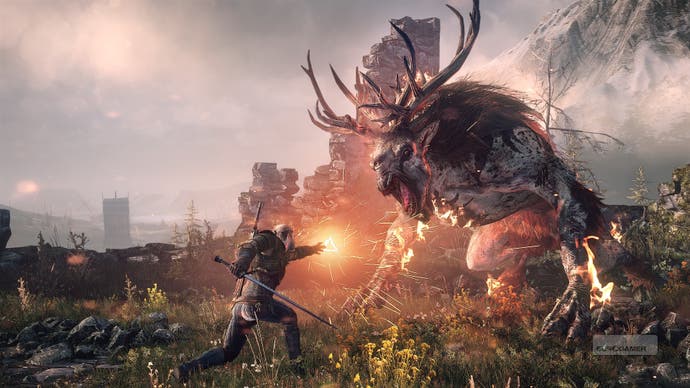
It's pleasing how naturally this encounter occurs out in the game world, and it's fun to think about tracking and hunting down bounties in The Witcher 3's broad wilderness on your own time, free of the game's structure and narrative impulse. But CD Projekt Red has much more elaborate monster-hunting scenarios than this to offer.
Following the trail of the Wild Hunt across a rugged, Celtic island, Geralt finds himself diverted by a village dispute. The young men of a village are quarrelling with the elders over the havoc wreaked by a monster lurking in a nearby forest, which the elders venerate as a woodland spirit and claim is only killing because the villagers have left the "old ways" behind them. (This sets up what is essentially a compulsory side-quest that interrupts the storyline, and is as elaborate and handsomely staged as you would expect an episode in the main quest to be. By using devices like this, as well as dynamic events out in the wild, CD Projekt hopes to avoid the fussy mini-maps and objective markers that bog down so many open-world games.)
Geralt agrees to investigate the beast -for a price. Venturing into the forest at night, fending off packs of wolves, he uses his 'witcher senses' - CD Projekt's take on the ubiquitous 'detective mode' visual overlay - to pick out clues to its identity in the forest. Cross-referencing these with his bestiary, we learn that the monster is a very old, male Leshen. The bestiary is an in-game encyclopedia that will give you the vital statistics, tells, abilities and vulnerabilities of the 80 or so monsters in The Witcher 3.
Geralt knows that the Leshen will have marked one of the villagers from which it draws power, and it won't be possible to kill it while that villager lives. In one of the morally ambiguous choices typical of the series, he must then decide whether to take this information to the weak elders or belligerent youth of the village. Our demonstrator sides with the latter - which the young men take as an excuse to slaughter the elders, even though Geralt discovers that a young woman was marked.
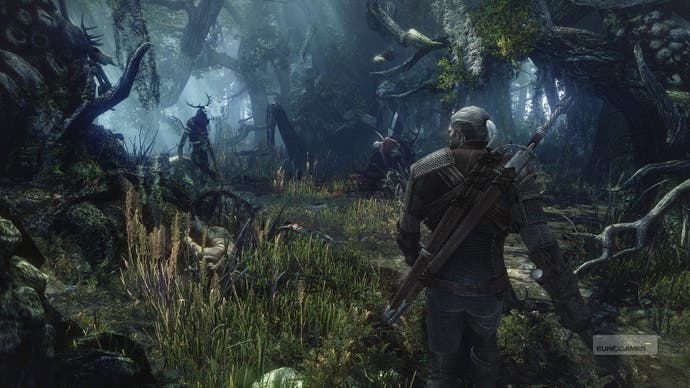
Potted medieval morality play over, Geralt heads into the woods by moonlight to slay the Leshen, a tall, crooked spectre with huge antlers who marks his territory with totems and commands wolves to defend him. It's a terrifically atmospheric and scary confrontation. It's a stormy night, and the rain and wind lash the trees and foliage of the woods relentlessly while Geralt engages in his fast-moving, tactical skirmish with the strange beast. After it dies and the quest is concluded, a short flash-forward narration notes melancholically that the people of the village outlived the monster that haunted them by only three months.
The Witcher 3 is plunging its roots deep into the black, loamy, fertile soil of central European folklore
The dialogue scenes are a little stiff - you can tell that CD Projekt is working at a disadvantage in English, and that performance capture isn't the studio's number one priority. And perhaps the grim cynicism of the tale, once refreshing to see in fantasy, comes off as a mite predictable in a world where Game of Thrones is a massive mainstream hit.
But there's something else going on here, tying both gameplay and plot deep into the one of the oldest archetypes of storytelling. The dark and stormy night, the chilling monster design, the bitter morality evident in the way the supernatural threat seems to prey on all too human weakness; with this trip into the woods at the dead of night, the Witcher 3 is plunging its roots deep into the black, loamy, fertile soil of central European folklore. Combine this with a world that has more grit and grain to it than Skyrim's, and the renewed focus on Geralt as beast-slayer - which extends across gameplay, plot, character development and lore - and you have, for my money, the most exciting prospect in solo role-playing games for quite some time.
"If you can see it, you can go there." The open-world refrain is all well and good, but perhaps what matters more in The Witcher 3 is going after what you can't see: into the woods, into the cave, into the dark unknown, to hunt the things that haunt your dreams.
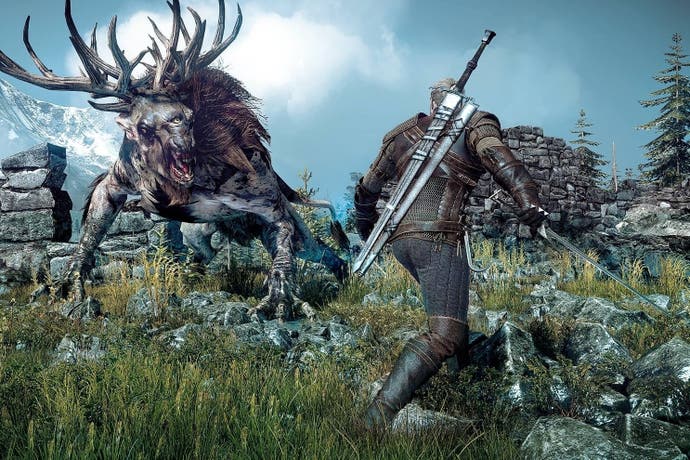


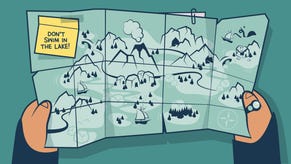
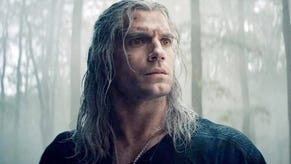
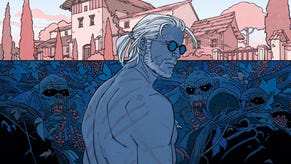


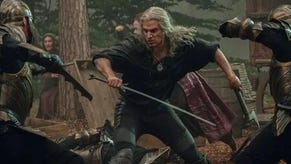
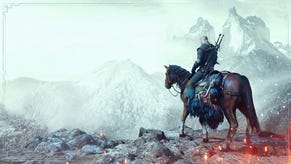



.png?width=291&height=164&fit=crop&quality=80&format=jpg&auto=webp)



